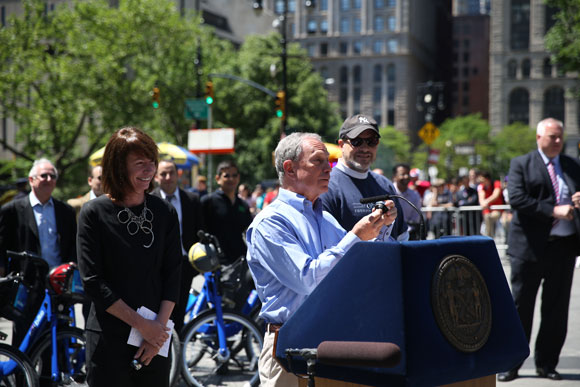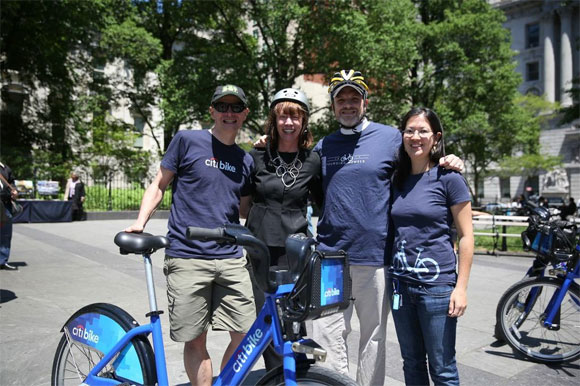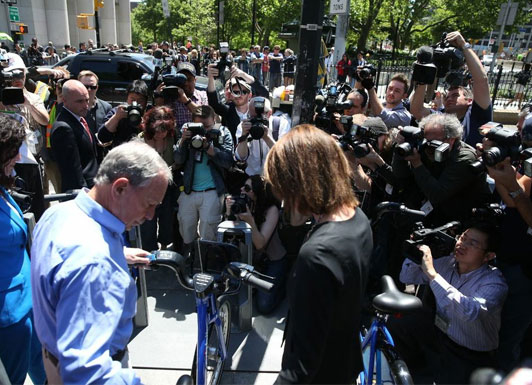
Five years ago, the New York City Department of Transportation signaled its interest in creating an extensive bike-share system "to accommodate a wide range of potential short trips." Now New Yorkers have that system at their fingertips. With today's launch of Citi Bike, there's a new travel option in the mix -- 6,000 bikes at 330 stations that will extend the reach of the transit system and expand access to the point-to-point convenience of bicycling.
"I am thrilled to declare that as of this moment, Citi Bike, the largest bike-share network in the country, is officially launched," Mayor Michael Bloomberg announced at a press event outside City Hall this morning. Touting a 75 percent reduction in the cycling injury rate over the past decade and the improved safety outcomes for pedestrians along the city's protected bike lanes, Bloomberg said that "Citi Bike will make our streets safer," and reiterated the city's commitment to ramp up to a 10,000-bike/600-station system.
While transportation funding stagnates and mega-projects run billions of dollars over budget and years behind schedule, the Bloomberg administration has delivered a new transit option at minimal public expense, with the potential to expand relatively quickly into other parts of the city. So far, more than 15,000 New Yorkers have signed up for the $95 annual pass, and about 13,000 now have access to the system using Citi Bike key fobs. On Sunday, June 2, the system will open up to weekly and daily members.
The culmination of intense study, planning, and public outreach, the bike-share launch marks the birth of a new transit network. "It's a rare thing to see a brand new transportation system become unveiled before our eyes," said Transportation Commissioner Janette Sadik-Khan. "We have the A Train, and the New York City cab, and the Staten Island Ferry, and now Citi Bike joins the ranks of the transportation icon family in New York City."
Within the service area, which at the moment extends from 59th Street in Manhattan to Bedford Stuyvesant in Brooklyn, bike-share gives New Yorkers the ability to go directly from point A to point B without the expense, hassle, and space-gobbling footprint of driving a car. The bike-share option is especially well-suited for some of the city's most vexing types of trips -- like getting across town or going anywhere on a weekend when subway service is disrupted. Soon GPS units embedded in each bike will provide a wealth of data about how New Yorkers use the system.
From the outset, Sadik-Khan, DOT Policy Director Jon Orcutt, and DOT bike-share program director Kate Fillin-Yeh strove to make a system that would be big enough to succeed. Since the bike stations are sited closely together, subscribers know they will be able to find a dock near their destination, as long as it's in the service area. And because the service area covers a big chunk of the city (though it could, of course, grow considerably over time), including the biggest job centers, a huge number of short trips are now feasible using the system.
The decision to go big "shaped everything we did," said Orcutt. "We weren't going to do anything but a system scaled for the city. There was never a thought of bike-share just for the East Village or something."

At the time Fillin-Yeh wrote a bike-share feasibility study for the Department of City Planning in 2009, the major systems were in Paris, Barcelona, and Montreal, which had just launched with the solar-powered stations that NYC would later adopt. "We looked at those as a model of how far stations were placed apart," she said, describing how the city determined the rough outlines of the initial service area and distribution of the bikes. "Then we started mapping that out and took a look at where are businesses in the city, where are hotels in the city, where are major institutions in the city, where are parks -- and built all that into a model based off that, population density, workforce density, and came to those numbers."
Today New Yorkers have a viable new transit network thanks to the foresight of the bike-share team and an administration that was not deterred by the scale of the undertaking or the setbacks that happened along the way. After extensive planning and station siting meetings, unforeseen software glitches and a potentially devastating hurricane strike, New York City bike-share is in motion.






